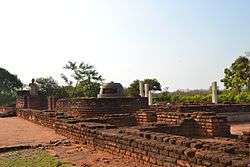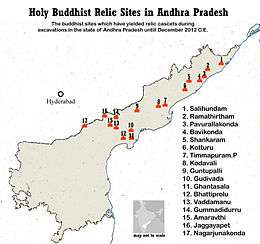Nagarjunakonda
| Nagarjuna Konda | |
|---|---|
| Native name నాగార్డున కొండ | |
 | |
| Location | Macherla, Andhra Pradesh, India |
| Coordinates | 16°31′18.82″N 79°14′34.26″E / 16.5218944°N 79.2428500°ECoordinates: 16°31′18.82″N 79°14′34.26″E / 16.5218944°N 79.2428500°E |
| Built | 225 AD - 325 AD |
| Architectural style(s) | Andhra(Amaravathi, Southern) School of Buddhist Indian Architecture |
| Governing body | Archaeological Survey of India |

Nagarjunakonda (meaning Nagarjuna Hill) is a historical Buddhist town, now an island located near Nagarjuna Sagar in Guntur district,[1][2] Andhra Pradesh, India. It is 160 km west side of another important historic site Amaravathi. It is one of India's richest Buddhist sites, known in the ancient times as Sri Parvata. It now lies almost entirely under the Nagarjunasagar Dam. It is named after Nagarjuna, a southern Indian master of Mahayana Buddhism who lived in the 2nd century AD, who is believed to have been responsible for the Buddhist activity in the area. The site was once the location of many Buddhist universities and monasteries, attracting students from as far as China, Gandhara, Bengal and Sri Lanka. The Buddhist archaeological sites there were submerged, and had to later be dug up and transferred to higher land on the hill, which had become an island.
History
The settlement of Nagarjunakonda (also Nāgārjunikoṇḍa) was the capital of the Ikshvaku dynasty (225 AD - 325 AD), the successors of the Satavahanas in the eastern Deccan. It is believed that Sadvaha authorised the first monastic construction there during his reign.
| Part of a series on |
| Buddhism |
|---|
 |
|
During the early centuries AD, the site housed more than 30 Buddhist viharas; excavations have yielded art works and inscriptions of great significance for the scholarly study of the history of this early period.[3] Nagarjuna was the exponent of the philosophy of sunyata (void). At the time, Buddhism often spread to Sri Lanka and Burma after using the area and the bustling Bay of Bengal ports of the Andhra to re-stock for the impending journey. Archaeological inscriptions at the site show that Sri Virapurusadatta, the second ruler of the dynasty was a Buddhist, as were his son Ehuvula and their descendants. The inscriptions also show state-sponsorship of construction of temples and monasteries, through the funding of the queen of Ikshvaku. Camtisiri in particular, is recorded as having funded the building of the main stupa for ten consecutive years. The support also spread beyond the noble classes, many non-royal names being inscribed in the relics. At its peak, there were more than thirty monasteries and it was the largest Buddhist centre in South India. Inscriptions showed that there were monasteries belonging to the Bahuśrutīya and Aparamahavinaseliya sub-schools of the Mahāsāṃghika, the Mahisasaka, and the Mahaviharavasin, from Sri Lanka. The architecture of the area reflects that of these traditions. There were other monasteries for Buddhist scholars originating from the Tamil kingdoms, Orissa, Kalinga, Gandhara, Bengal, Ceylon (the Culadhammagiri) and China. There is also a footprint at the site of the Mahaviharavasin monastery, which is believed to be a reproduction of that of Gautama Buddha.
The region declined after the death of Rudrapurusa, the last Ikshvaku king. Excavations began in 1927, and the first finds were made by English archaeologists in 1928. The excavations were continuous until 1931. They unearthed the ruins of stupas and chaityas in 1926 at what was once an immense centre for Buddhist learning in ancient India. This was expanded in 1954 to include the whole valley, unearthing more than 100 further relics dating from the stone age to the 16th century.
The great stupa at Nagarjunakonda belongs to the class of uncased stupas, its brickwork being plastered over and the stupa decorated by a large garland-ornament.[4] The original stupa was renovated by the Ikshvaku princess Chamtisiri in the 3rd century AD, when ayaka-pillars of stone were erected. The outer railing, if any, was of wood, its uprights erected over a brick plinth. The stupa, 32.3 m in diameter, rose to a height of 18 m with a 4 m wide circumambulatory. The medhi stood 1.5 m and the ayaka-platforms were rectangular offsets measuring 6.7 by 1.5 m.[5]

An archaeological catastrophe struck in 1960, when an irrigation dam was constructed across the nearby Krishna River, submerging the original site under the waters of a reservoir. In advance of the flooding, several monuments were dug up and relocated to the top of Nagarjuna's Hill, where a museum was built in 1966. Other monuments were relocated to the mainland, east of the flooded area. Dedicated archaeologists managed to recover almost all of the relics.
Nagarjunasagar Dam
The Nagarjunasagar Dam is the tallest masonry dam in the world. The excavated remains of the Buddhist civilisation were reconstructed and preserved at a museum on the island situated in the midst of the man-made Nagarjunasagar Lake. The site has a 14th-century fort, medieval temples and a museum constructed like a Buddhist vihara. The museum houses a collection of relics of Buddhist culture and art. These include a small tooth and an ear-ring believed to be that of Gautama Buddha. The main stupa of Nagarjunakonda named Mahachaitya is believed to contain the sacred relics of the Buddha. A partly ruined monolithic statue of the Buddha is the main attraction at the museum. It also houses historic finds in the form of tools from Paleolithic and Neolithic times, as well as friezes, coins and jewellery.[6][7]
Tourism
Located in Guntur district[8] it is not accessible on the State Highway. The nearest train station is at Macherla, 29 km away. It is connected by a ferry to the mainland.

The area is also known for panoramic views of the valley from a viewing area near the dam, and is also the site of natural waterfalls, Ethipothala Falls which cascade down 22 m into a blue lagoon that is also a breeding centre for crocodiles. The nearby Srisailam wildlife sanctuary, a Project Tiger reserve and refuge for diverse reptiles, birds and animals. Srisailam, which sits on the shore of Krishna in the Nallamala Hills is a site of immense historical and religious significance, including a Shiva temple that is one of the 12 sacred Jyotirlingas.
References
| Wikimedia Commons has media related to Nagarjunakonda. |
- ↑
- ↑
- ↑ Ancient India
- ↑ The Stupa: http://www.wuys.com/news/Article_Show.asp?ArticleID=8303
- ↑ Visit Lord Budha - Nagarjunakonda Archived January 4, 2006, at the Wayback Machine.
- ↑ City information of Hyderabad, Nagarjunasagar, Nagarjunakonda, Warangal, Medak
- ↑ Tourism of India - Buddha - Excursion
- ↑
- Archaeological Survey of India (1987). Nagarjunakonda.